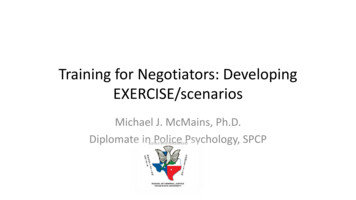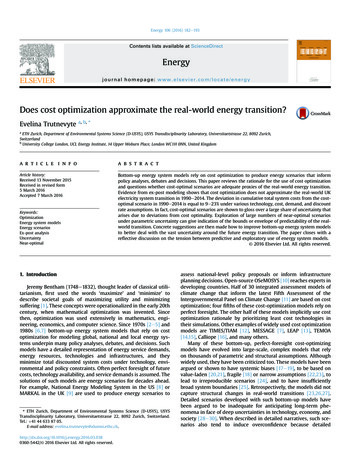
Transcription
Training for Negotiators: DevelopingEXERCISE/scenariosMichael J. McMains, Ph.D.Diplomate in Police Psychology, SPCP
The Philosophy of the Class
Goals for the Day Understand the need Discuss the process Practice the skills
The need After ever school, contest or practice exercisePostings on Negotiator CentralDiscussion with BobShow of hands
Overall goal of training- Competence
Maslow’s Stages of Learning
General Principles– Practice like we play-make it as realistic as possible– Treat feedback “as if”– Repeat until it is a habit– End on success
Skills Training ModelFEEDBACK
Sources of training ideas HOBASLocal MediaNational MediaDebriefs of Prior TrainingDebriefs of incidents
About actor Avoid cops Avoid cops Avoid cops
Methods of training Structure – the structure is the method of training being used for the exercise, including:– Didactic presentations- what to do– Case studies- what to do– Table-top discussion- what to do– Back to back- Primary- what and how– Back to Back- Primary and coach-what and how– Exercise- negotiations team- what and how– Exercise- whole crisis management team- what and how
Crisis Crisis Act 1: Action builds drama, defines pre-crisis tensions, needs and actionsAct 2: crisis comes to a head and police get involvedAct 3: resolution- either positive or negative depending on actions of the negotiators.
The process Goals-Defining training goals Objectives-Breaking goals into observable parts-the objectives thatsupport the goals. Operationalizing-Determining what parts of the context will allowyou to observe and test the objectives Action-Defining action that needs to be in the scenario to allowobservation and assessment of the goals Feedback-Providing feedback on the observation Discussing feedback and plan for corrections when needed
Training Goals Individual Negotiator Skills- specific skills in which a negotiator needs to be competent Negotiation Team Skills- skills in working together with other people efficiently and effectively Inter-team goals- skills in coordinating and management of all elements of a critical incident
identifying the goals Individual training goals– Develop ability analyze incident– Practice and refine active listening skills to . Team training goals– Refine communication between team members to .– Develop brainstorming skills Inter-team training goals– Practice triad of command problem-solving – Develop coordinated communication system for EMT
objectives: making it observable Develop individual skills in analyzing incident– What elements need to be analyzed? Risk of violence? Type of incident? Personality of the person taking hostages? How do we operationalize them? How do we capture negotiators performance?– Observation sheets- pre-structured?– Observation sheets- free form.
Operationalizing-Developing contextRisk Factors in Domestic Violence. Risk of violence in a domestic incidentPrior violence in same household.Prior violence in public.Violence in home of origin.Chaotic relationship with current victim.Recent loss.Increasing pattern of violence.Neurological Impairment.Victim trying to leave relationship.Risk Factors for Femicide.Choking of victim.Forced sex with victim.Threats to kill victim.Excessive controls over victim.Child abuse.Abuse of victim while she was pregnant.Victims believes abuser is capable of killing her.Violent jealousy.
action Where, when what and who to build into the scenario?– Intel from actor-after a relationship has developed– Intel from family- introduced 2 hours into scenario, relates priorsuicide attempts– Intel from friends– Intel from officers- interviewing responding officers, beat officer. Act one: what needs to be in history? Act two: What needs to be in onset of scenario that brought police into people’s lives? Act three: What needs to be in conclusion
observations– Structured observation - a sheet developed before the exercise thatidentifies the specific skills to be practiced and observed.– Spontaneous-unstructured; observations that are relevant that occurduring the exercise but have not been identified as a training goal orObjective.– Observations can come from an observer who is not part of the teamor from team members who notice issues to which the team needsto attend.– Teams can review video tapes of their own performance - generateshelpful, insights for teams.
Observations sheet-immanent riskRisk Factors in Domestic Violence.Prior violence in same household.Prior violence in public.Violence in home of origin.Chaotic relationship with current victim.Recent loss.Increasing pattern of violence.Neurological Impairment.Victim trying to leave relationship.Risk Factors for Femicide.Choking of victim.Forced sex with victim.Threats to kill victim.Excessive controls over victim.Child abuse.Abuse of victim while she was pregnant.Victims believes abuser is capable of killing her.Violent jealousy.
Feedback – the observer’s comments on the attainment of the training goals andobjectives. Observers should be experienced negotiators who have competence inthe skills being observed.– Dialog- a conversation between an objective observer and the negotiatorswhich provides the negotiators an opportunity to discuss he observationsmade by the observers. Done in the spirit of improving performance; notattacking people. Feedback can be done during the exercise when the observerstops the action and structures a dialog or at the end of the exercise.– Replay-redo- if observations are made during the exercise, it is negotiators canbe asked to pick up the scenario where it was left before the feedback or rewind and re-play the exercise from a point before they were required to usethe skills on which the observer provided feedback.
feedback AttitudeConcreteSpecificWith examplesManageable chunksRoom for discussion
Pause and ponder What sticks with you? What can you use in your next training?
Checklist Goals of Training– Individual Skills– Team Skills– Intra-team skills Structure – Role playReference Template Handout
Checklist Observation –– Structured- observation sheet needed– Unstructured Feedback– Dialog– Replay-redo
Checklist Scenario– What – original call– Where – ADDRESS, location, floor plan, obstacles, utilities– When – time of day, external events that might influence actor– How– Why
Checklist Who: character – why – motives-Issues– Motives– Intelligence– History of relationships– Attitude toward Authority Land mines/triggers/barbs History– Intellectual
Checklist Add ins- intelligence inserts Subtractions Actions– Scripted – test specific issues– Spontaneous from interactions
Timeline for scenarioHour1234567ActionExpected responseInserts
Training ProceduresStructure – the structure is the method of training being used for the exercise, including:– Table-top discussion– Back to back- Primary– Back to Back- Primary and coach– Exercise- negotiations team Exercise- command, tactical and negotiators
Exercise Home invasion
CNT Scenariohome invasion This is an eight hour scenario designed to teach new negotiators how torecognize the nature of a call-out, engage the subject, assess the risk posedby the subject, manage the HN’s demands and control the subject withoutraising resistance. It will be monitored by instructor/observers who will coachthe negotiators and the negotiations teas during the exercise, using astructured observation sheet to inform their observations and feedback.Home Invasion
Checklist Reference Template HandoutGoals of Training– Individual Skills Officers will demonstrate skill in their individual roles on a negotiations team. Communicating effectively with the actor, supporting the primary, gathering andusing actionable intelligence, recording important information, managing the team,– Team Skills Team will show skill in communicating, analysizing and managing relevantinformation. Will demonstrate effective brain-storming in developing strategies for dealing withthe incident.– Intra-team skills Structure – Role play
procedure Structure– Role play exercise with intelligence inserts and interviews with significant sourcesincluding released hostages.– NPP exercises throughout the scenario (See attachment). Observation/feedback– Structured- observation forms will be used to document observer/mentors observations(see attachment).– Unstructured- other relevant comments, as appropriate by observer/mentors Feedback– Periodic Coaching-by the observer with the teams
scenario What– Original call-On this day, the dispatcher got a 911 call from a female named AudraMaria Wilson . The caller reported that a subject, Paul Paulson, had broken into theapartment and shot the caller’s father in the shoulder. The caller was hiding in thebedroom and was afraid to talk too long. Responding officers were met by a man witha gun who fired shots at the officer and barricaded himself in the apartment, statingthat he would “kill everybody, if you cops try to come in here.” He is barricaded withhis ex-girlfriend's mother with three hostages and weapons.– Patrol has requested the Crisis Management team and your negotiations team havebeen mobilized.– A five-block area of the neighborhood is isolated. Police cordoned the area andordered residents to stay in their houses. Some residents were evacuated to a localschool for their own safety.
scenario Your team is on site and a CP and Negotiation area has been set up. The Special operationsCommander is asking your assessment of: Whether or not this incident is negotiable? What resources you will need to do your job? How dangerous is the actor?
scenario Where– Refugio Place, 300 Labor, San Antonio, TX 78210– 2nd floor apartment.– Floor plan- attached– Utilities,– Obstacles- furniture in apartment- gain intelligence from escaped hostage.– Phone Number: When – This date, 0830 How- Call to dispatcher by one of the hostages- from cell phone #
Character WHO – why –Motives- fear of loss of control and abandonment. Attitude toward Authority- rebellious, anti-authority. History oftrouble with authority: school, jobs. Dependent on mother andattorney. Land mines- Impulsivity and erratic emotionally. Slightest suggestionof disrespect precipitates angry out bursts. During outburstsimpatient and demanding- wants demands met, NOW In calmer periods, is more understanding about delays. Uses phonecalls to rationalize behavior- blaming girlfriends and their familymembers for his violence. Ultimately depends on others for solutions
background– History: Earlier on the same day, he had broken into a house insoutheastern part of the county and stolen a handgun and two rifles.He had not hurt the residents of the house.– TPI- In an early in the incident, an attorney who had represented theman since the mid-1990s, asked him to surrender and he complied. Subject’s Background-Court records show SEE BELOW
Intelligence Inserts– TV news broadcasts– Police reports of shootings Intelligence sources Mother- Rachel Attorney- Dewey Cheatem “Girlfriend” Escaped hostage-Meara
Initial action Action- When the negotiators make contact, the actor is agitated, angry and shouting. He– Demands: Central- he demands to talk to his former girlfriend, that the police stay back and threatensto kill people if he sees any police. Peripheral- talk to attorney. Peripheral- make statement to media Peripheral- talk with mother
action Scripted – test specific issues– Individual Team Member’s skill in each role– Primary– Secondary– Intelligence– Boards/scribe– Team Leader– Mental Health Spontaneous from interactions
scriptTimeScripted ActionsNegotiator’s goals1st hourInitial callSet up and assess incident.Develop openingstatement.Identify intelligenceinformation needed andsources.Make initial contact.Appropriate ResponseActor’s response
1st HourInitial ContactKeep actor on the phone.IN CRISIS- were not expecting police.Allow/encourage actor toCentral feeling: Fear.ventilate.Demands1-Defensive threats- stay away orShow patience, empathysomebody will die.and acceptance.Yell about seeing the SWAT Team out yourValidate frustration butwindow.not actions.You have seen what happens in thesesituations- you watch the news. You have Deal with safety issuesdealt with the police before. Been toprison and was poorly treated andabused. Don’t want to go back.2- Demand to get girlfriend over here soyou can talk to her face-to-face; youbelieve that if you can just talk to her, youcan talk her into or bully her into runningaway with you. You “know” that it was thepolice who talked her into staying awayfrom him, after you had kidnapped herand she escaped.Deny it was a kidnapping.Initial motivation: Fear for safety-Keeppolice at bay and get in contact with exgirlfriend.You see police movement and react withthreats and demands that they get back.Introduce selfReassuranceBLSOpen-endedquestions/statements thatinvite you to tell your story.Encouragers- pauses, minimalencouragers, mirroring,paraphrasing, reflection offeelings, etc. that keep youtalking.Summary when they think theyget your concerns.
2nd HourCore feelings- anger atdisrespect.Agitated by TV news coveragewhich describes you as a violentperson who has beenhospitalized. Accurate report butyou are hyper-sensitive aboutbeing disrespected.Angry at what you perceive asdisrespect. Rationalize use offorce in earlier episode-blamingthe victim: If he had minded hisown business, he wouldn’t havegotten hurt.1-Demand to make a statementto the press. Want a reporter tocome in the apartment tointerview him.2- Failing to get reporter inside:Demand that the negotiatorsremove the press from the areaand they run a retraction.Defuse againContinue to gatherintelligence.Manage demands tomake a statement topress.BLSReflecting demands.Breaking demands down.Asks for time to get it all done.Same as above to defuseanger.Deals with demands byreflecting them andexplaining the many stepsinvolved in influencing media.
3rd HourMother shows up at scene-want to talk toactor. Has seen TV report. Can fill inbackground.Actor:1-Demands girlfriend still top priority.2-Actor demands to talk to attorney ormother.Gives contact information.Feeling more confident about safety for themoment. Can focus on Central demands ofgetting the girlfriend down to the scene.Talk about how she will come into theapartment when she gets there.Rationalizes her escape from earlierkidnapping- four weeks ago- as “the policepoisoning her against me.”Management of demands:CentralPeripheralIf negotiators manage demand forgirlfriend by reflecting andreporting on progress, otherdemands surface.
4th HourCore emotion: Fearbeginning to realize heis not getting girlfriendand live happily everafter. Needs to talk toattorney to see if hecan make a deal tokeep out of jail oradvice on what to do.Demands to talk toattorney “right away.”Attorney is unavailableas TPI.Demands: Actorpresses hard on issueof attorney or mother.Don’t trust negotiatorsenough to accept themas a go-between-youand attorney ormother.ALS- recognizesfear anddependency.Has to managethe demand totalk to attorneyand whether ornot to allow a PI
OBSERVATION Team TasksGathered intelligence about the incident, the hostage taker, the hostages, etc.Assessed RiskDefused the incidentInfluenced the hostage takerReduced the risk of loss of life.Established effective communication with the hostage taker.Recorded relevant intelligence information. Kept a record of the negotiations, including demands and promises. Maintained equipment. Coordinated and communicated with incidentcommander and tactical team.
Team MemberRoleTasksTeam LeaderLeads andManages Team.Communicates withcommand.Team MemberPrimary NegotiatorRoleCommunicates withhostage-actor.Brainstorms with team.Team MemberSecondary/CoachRoleCommunicates betweenprimaryand team.Brainstorms with team.Assures effective overall team functioning:Selects team.Coordinates training.Provides input to on-scene command staff.Assesses negotiability.Makes it negotiable.Ensures communication between commandstaff and all members of Negotiations team.Mission“Everybody Goes Home.”“As Many as Possible Go Home.”1.Facilitates problem-solving.2.Manages personal stress and anxiety.3.Develops verbal tactics that:4.-Establishes trust and rapport withactor.5.-Diffuses emotion.6.-Facilitates dignified surrender.7.Gathers intelligence from ksAssists team and team leaders.Helps develop communication strategyand tactics.Helps plan the direction ofnegotiations.Monitors the primary for signs ofstress; helps manage.Coaches primary-good communicationskills.Replaces primary, if necessary.Comments/ExamplesComments/Examples
–Individual Skills Officers will demonstrate skill in their individual roles on a negotiations team. Communicating effectively with the actor, supporting the primary, gathering and using actionable intelligence, recording important info










